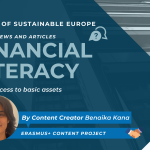Written by Douaa Batersh
Reading time: 4 minutes
A Green Revolution in Food Packaging
Packaging is crucial in ensuring the quality and safety of food, protecting it from various contaminants, and extending its shelf life. Materials used for packaging food must be economical, durable, and possess good barrier properties. One of the major challenges faced by the food industry is developing an eco-friendly, economical, and sustainable packaging system.
The conventional materials, which majorly depend on petroleum-derived polymers, are associated with several significant problems, such as environmental pollution, depletion of resources, generation of single-use wastes, leakage of chemicals into food products, limited recycling, and so on. As the food sector focuses on reducing its environmental impact, by encouraging revolutionary changes for an effective sustainable food packaging approach. The core objective of industrial packaging was to innovate a biodegradable material, especially derived from renewable biomass resources as eco-friendly alternatives in the food industry.
One of the significant trends involves production of bioplastics, which are derived from renewable polymers such as corn starch, sugarcane, or algae. These materials offer a viable alternative to traditional petroleum-based plastics, as they are often compostable or biodegradable. The development of advanced bioplastics with improved barrier properties and durability is gaining traction, addressing environmental and health concerns and functionalizing a packaging material.
The present review discusses the limitations of conventional packaging materials used in the food industry and focuses on the various polymers derived from natural sources, their physio-chemical properties, and their potential application as a sustainable material that reduce carbon emission, and enhance preservation of food and ensure food safety. Eco-friendly innovations in food packaging: A sustainable revolution – ScienceDirect.
Key Functions of Food Packaging
As a biotechnology for food sciences student, the packaging of food is essential for their shelf life by acting as a barrier against external factors, such as moisture, light, and oxygen, which can degrade the quality of the food. It also protects against physical damage during
transportation, and provides essential information to the consumer.
This includes nutritional facts, ingredients, expiration dates, and cooking instructions. It helps consumers make informed choices about the food they consume since most people are allergic to many ingredients that may be used in food for example: while making the bovine cheese it is important to mention if you will be using another type of milk to avoid risking the life of people.
Moreover, Packaging plays a crucial role in branding. The design, colors, and logos help in product differentiation and can influence consumers’ purchasing decisions. It’s a tool for businesses to communicate their brand’s values and story, as well as foods that need to be contained in some way to be handled efficiently.
For instance, liquids need a container, and powders need sealing to prevent dispersal, which means that they require a controlled atmosphere to prolong shelf life by which packaging can help maintain specific gas compositions, like reduced oxygen levels, to keep food fresh.

The Impacts of Packaging on the Environment.
Petrochemical plastics have found the most usage in food packaging industries because they are cheap, have good tensile properties, and represent an effective barrier against oxygen, carbon dioxide and water vapour. A wide variety of these plastics have been used in packaging in both flexible and rigid form. In the packaging industry, food packaging accounts for 50% of the plastics derived from fossil fuels. When food is thrown away, so does the packaging material where it was contained.
These fossil fuel plastics are persistent in the environment and take many years to degrade. As they do, they break into microplastics, which can easily enter the food chain when consumed by, for example, fish, leading to bioaccumulation. Growing environmental concerns have placed packaging under scrutiny as it is a constant source of high amounts of plastic waste and this has brought about the need to do extensive research into renewable alternatives.
Packaging materials in use today are chiefly fossil fuel-based plastics and their annual production continues to rise. Therefore, it is imperative to bear in mind that the best solution to lower plastic waste in the environment is better waste management, particularly in developing countries . The adoption of green packaging is vital and three types of green packaging have been identified namely:
- Reusable packaging, e.g., glass which can be reused after cleaning.
- Recyclable packaging, e.g., paper which can be reprocessed and reused.
- Biodegradable packaging, e.g., cotton sacks which can break down into the environment without causing damage
From Pollution to Solution: The Role of Sustainable Materials
Plastics and chemicals contribute greatly to the devastation of our environment. According to research done by Our World In Data, more than 8 million tons of plastic make their way into the sea annually, endangering marine life. Sea turtles, seabirds, and other marine animals often mistake plastic waste for food, which leads to fatal consequences.
Not only does this endanger wildlife, but microplastics have entered the human food chain, with traces now found in seafood and drinking water, exacerbating health risks. Harmful chemicals used in industrial processes, such as volatile organic compounds (VOCs) and heavy metals, further aggravate environmental pollution by contaminating air, water, and soil. These pollutants contribute to chronic respiratory conditions, water contamination, and degraded soil quality, causing long-term damage. Therefore, adopting alternative materials to plastic is critical for addressing these pressing environmental challenges. As more people are made aware of these issues, so is the demand for sustainable solutions, with the sustainable materials market projected to reach $1.1 trillion by 2025, according to Future Data Stats.
By embracing eco-friendly materials like bamboo, recycled metals, and biodegradable polymers, industries are actively reducing waste, decreasing their carbon footprint, and contributing to a circular economy. For example, bamboo’s rapid growth and minimal resource requirements make it an excellent substitute for wood and plastic in a variety of applications, from packaging to construction. The sustainable construction materials market is also expanding rapidly. According to Statista, this market is expected to hit $1.9 trillion by 2028, driven by the adoption of green building practices. By incorporating alternative materials to plastic in construction, such as recycled steel and low-impact concrete, the industry is lowering greenhouse gas emissions and enhancing the longevity of structures.
Traditional plastic containers and bottles are known for their long degradation periods, but plant-based packaging offers a viable solution. Materials like cornstarch, algae, and mushroom mycelium are increasingly used to create biodegradable packaging that breaks down faster than conventional plastics.
- Plant-Based Bottles: The beverage industry is embracing bottles made from plant-based materials, like sugarcane. These bottles offer the same look and feel as plastic but come from renewable resources, drastically reducing their environmental impact.
- Mycelium Packaging: Mycelium, the root structure of mushrooms, is being used as an innovative material to replace plastic foam in packaging. It grows quickly, using agricultural waste as its food source. Mycelium forms a strong, lightweight structure that can be
molded into various shapes. Once used, mycelium-based packaging biodegrades naturally within a few weeks. This makes it a highly sustainable alternative for protective packaging in industries like electronics and furniture. - Algae Packaging: Algae-derived packaging is a promising innovation for single-use products. This material degrades rapidly, making it ideal for packaging items like toiletries and food products.
- Seaweed Packaging: Another fascinating alternative to plastic is seaweed-based packaging. Seaweed grows rapidly in oceans without the need for freshwater or fertilizers. It can be processed into films and containers serving biodegradable packaging for food items, beverages, and other goods. This reduces reliance on petroleum-based plastics and contributes to ocean health by absorbing carbon dioxide and producing oxygen during growth.

Conclusion
Food packaging is essential for maintaining the safety and quality of food, protecting it from contaminants, and prolonging its shelf life. Nevertheless, some packaging materials can leach harmful chemicals into food, which can pose serious health risks. For example, compounds like Bisphenol A (BPA), Perfluoroalkyl substances (PFAS), and phthalates have been associated with critical health issues, including cancer, endocrine disruption, and organ toxicity. The environmental impact of food packaging is also alarming. Conventional packaging materials, particularly plastics, significantly contribute to pollution, with large quantities ending up in landfills and oceans, thereby disrupting ecosystems and endangering wildlife.
To address these challenges, it is vital to embrace sustainable packaging solutions. Eco-friendly materials, such as compostable, biodegradable, and recyclable options, are emerging as effective alternatives to traditional plastics. These materials not only lessen environmental harm but also tackle the urgent problem of waste disposal, offering a remedy for the pollution generated by non-recyclable packaging. Although the upfront cost of sustainable packaging may be higher, investing in these alternatives is a necessary measure to protect human health and maintain environmental integrity. By adopting eco-friendly packaging, we can significantly mitigate the negative effects associated with conventional materials, fostering a healthier planet for future generations.

douaa-batersh
“Douaa is a 22 years old Biology student at the Lebanese University Faculty of Science. Born and raised in the capital of Beirut and interested in doing her Master’s in Forensics Science abroad. Moreover, Douaa is interested as a researcher in the field of environmental sustainability and its effects on the overall biodiversity, that’s why she got in touch with CoSE and immediately was interested to join the team to raise awareness on this important topic, not only from a European perspective but also for the Middle-Eastern youth in general. She is particularly focused on fashion design and its recycled and organic materials. Therefore, she is hoping to mash both natural materials and clothing together to reach sustainability in the fashion industry.”
Bibliography;
Eco-friendly innovations in food packaging: A sustainable revolution – ScienceDirect
Sustainable construction materials market value worldwide| Statista
What is Plant-Based Plastic and How it Works | TIPA
7 Eco- Friendly Alternative Materials to Plastic for 2024 and Beyond

